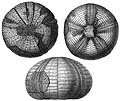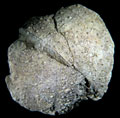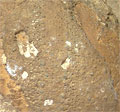The Echinoid Directory
Megapedina Lambert & Thiery, 1911, p. 205
| Diagnostic Features |
|
|---|---|
| Distribution | Middle Jurassic (Bathonian) to Late Jurassic (Oxfordian), France. |
| Name gender | feminine |
| Type | Pedina charmassei Cotteau, 1884, by original designation. |
| Species Included |
|
| Classification and/or Status |
|
| Remarks | The distinction of this species from Pedina sublaevis is largely one of size, although Lambert & Thiery erected this genus on the basis that the ambulacral plating was more regularly trigeminate (i.e. primary tubercles were present on most ambulacral plates). Although this is true, there is still a distinct heterogeneity in the size of ambulacral tubercles and therefore this genus is treated as a synonym of Pedina. |








